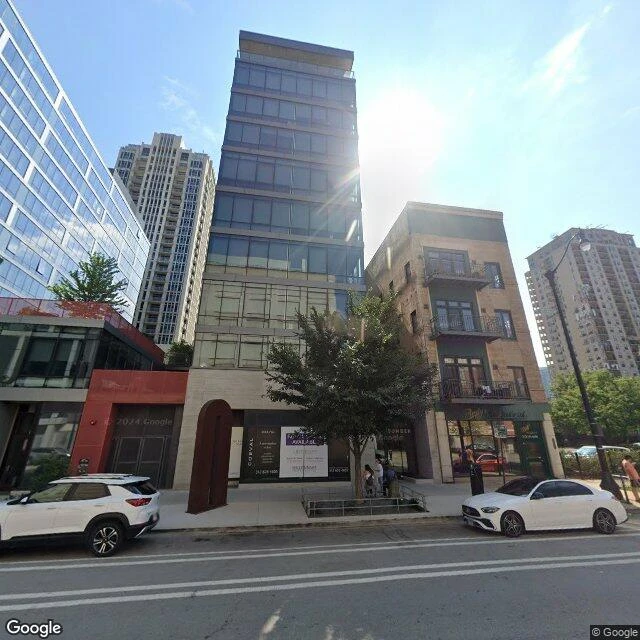
Attribution: © Google 2025
Building Info
- Square Footage
- 53,352 sqftLower than 96% of all buildings1/3 median139,707 sqft1/3 median Multifamily Housing144,765 sqft
- Built
- 2019
- Primary Property Type
- Multifamily Housing
- Community Area
- Ward
- 3
-
Chicago Energy Rating
- 4.0 / 4
-
Energy Star Score
- 100 / 100
- Owner
2022 Report Card
Debug Full Grade Data
- AvgPercentileLetterGrade: A
- AvgPercentileGrade: 92.52941176470588
- GHGIntensityLetterGrade: A
- GHGIntensityPercentileGrade: 98.3921568627451
- EnergyMixLetterGrade: A
- EnergyMixWeightedPctSum: 100.0
- EnergyMixPercentileGrade: 100.0
- SubmittedRecordsLetterGrade: D
- MissingRecordsCount: 2.0
- SubmittedRecordsPercentileGrade: 33.33333333333333
Emissions & Energy Information for 2022
- Greenhouse Gas Intensity A
- 2.4 kg CO2e / sqftLower than 98% of all buildings1/3 median6.4 kg CO2e / sqft1/2 median Multifamily Housing5.7 kg CO2e / sqft
- Total Greenhouse Gas Emissions
- 129 tons CO2e#15 Lowest in Chicago* 🏆#9 Lowest of Multifamily Housing Buildings 🏆1/7 median885.8 tons CO2e1/6 median Multifamily Housing770.6 tons CO2e
Years Reported
1/3
D

2020
2021
2022
Energy Breakdown
- Fossil Gas Use (aka Natural Gas)
- 0 kBtu#14 Lowest of Multifamily Housing Buildings 🏆Lower than 97% of all buildingsMedian Chicago Building5,818,399.6 kBtuMedian Multifamily Housing6,538,862.3 kBtuThis Building Didn't Burn Any Fossil Gas! 🎉
This building burned no fossil gas on-site and isn't connected to a district heating system, meaning it's fully electric! View Chicago's Biggest Gas Free Buildings .
- Electricity Use
- 979,758 kBtuEst. Electric Bill: $41,000 for 2022**Lower than 91% of all buildings1/4 median3,796,376.7 kBtu1/3 median Multifamily Housing2,848,153.7 kBtu
Energy Mix A
Total Energy Use: 979,758 kBTU
View Extra Technical & Historic Info
- Source Energy Usage Intensity
- Not Reported
This data was not reported for this building this year, which likely means a value of zero for this field.
- Site Energy Usage Intensity
- Not Reported
This data was not reported for this building this year, which likely means a value of zero for this field.
Full Historical Data Table for Coeval 2
| Year |
Overall Grade |
Emissions Intensity Sub-Grade |
Energy Mix Sub-Grade |
Reporting Mix Sub-Grade | GHG Intensity kg CO2e / sqft | GHG Emissions metric tons CO2e | Energy Mix | Electricity Use kBTU | Fossil Gas Use kBTU |
District Steam Use kBTU |
District Chilled Water Use kBTU | Source EUI kBTU / sqft | Floor Area sqft |
Chicago Energy Rating |
Energy Star Score |
|---|---|---|---|---|---|---|---|---|---|---|---|---|---|---|---|
| 2020 | - | - | - | - | - | 53,352 | 0.0 | - | |||||||
| 2021 | - | - | - | - | - | 53,352 | 0.0 | - | |||||||
| 2022 | A | A | A | D | 2.4 | 129 | 100%Electricity 0%Fossil Gas 0%Other | 979,758 | - | - | - | 51.4 | 53,352 | 4.0 | 100.0 |
* Note on Rankings: Rankings and medians are among included buildings, which are those who reported under the Chicago Energy Benchmarking Ordinance for the year 2022, which only applies to buildings over 50,000 square feet.
** Note on Bill Estimates:
Estimates for gas and electric bills are based on average electric and
gas retail prices for Chicago in 2021 and
are rounded. We expect large buildings would negotiate lower rates with
utilities, but these estimates serve as an upper bound of cost and help
understand the volume of energy a building is used by comparing it to
your own energy bills! See our
Chicago Gas & Electric Costs Source
for the original statistics.
Data Source:
Chicago Energy Benchmarking Data